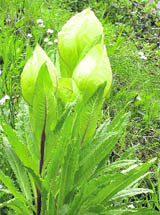 |
| Brahm kamal (Saussurea Obvallata) |
Courtesy ecological degradation and excess exploitation of this variety
Pithoragarh, November 22
The existence of Brahm kamal (saussurea obvallata), the state flower of Uttarakhand, is in crisis due to the worldwide ecological degradation and the excess exploitation of this high-Himalayan variety after the creation of the state, claimed Dr Naveen Joshi, an Ayurvedic doctor and researcher on this flower.
According to Dr Joshi, due to religious uses in the Himalayan region and accessibility of the villagers to the areas where it grows, the exploitation of this flower has increased in the recent years leading it to its possible extinction. The height of 11000 feet at which this flower starts appearing is now accessible and as a result, the specific variety of ‘Kasturi Kamal’ cannot be found,” said Dr Joshi.
He said due to its aphrodisiac and aromatic values in Tibetan medical system, the oil of Brahm Kamal is being extracted in a large quantity in Tibet.
“The handbook of traditional drugs cites 174 formulations of this rare flower in Tibet,” said Dr Joshi.
”Not only in Tibet, but in the Chinese medical system a number of perfumes are prepared out of the oil extracted from this flower, which are used for aphrodisiac purposes in that country. Due to this increased use, the Chinese are purchasing this flower from the Tibetan nomads,” said Dr Joshi.
He said in the Indian Ayurvedic system, the Himalayan flower is known as ‘Kooth’ in Ayurveda, which has described its 64 varieties in the Himalayan region. ”In Ayurveda, the uses of Brahm Kamal are meant for antiseptic medicine, medicine to be used for paralysis,
asthma, cholera and many other skin diseases,” said Dr Joshi, who has been researching on the medicinal uses of this flower for a long time.
“But the flower found in the Himalayan glaciers from Yangon in Myanmar to western China on both side of the Himalaya in 62 varieties, including all 36 varieties in the Indian Himalayas, is in a bad shape as the Tibetans are extracting its oil for medicinal uses and the Indian villagers are using it for religious purposes,” said Dr Joshi.
The special variety of this flower, named Kasturi Kamal, known in Ayurvedic as the king of Himalayan flowers, is found at heights of more than 16000 feet, especially in the areas of the Chiplakedar and Hiramani glaciers of Uttarakhand, are in danger of being extinct as the villagers are recklessly extracting these flowers in large quantities to offer it to the goddesses of Nanda and Sunanda in September every year.
”Until this tendency of indiscriminate plucking of this flower is not checked, the state flower of Uttarakhand will be in danger,”’ cautioned Dr Naveen Joshi.
